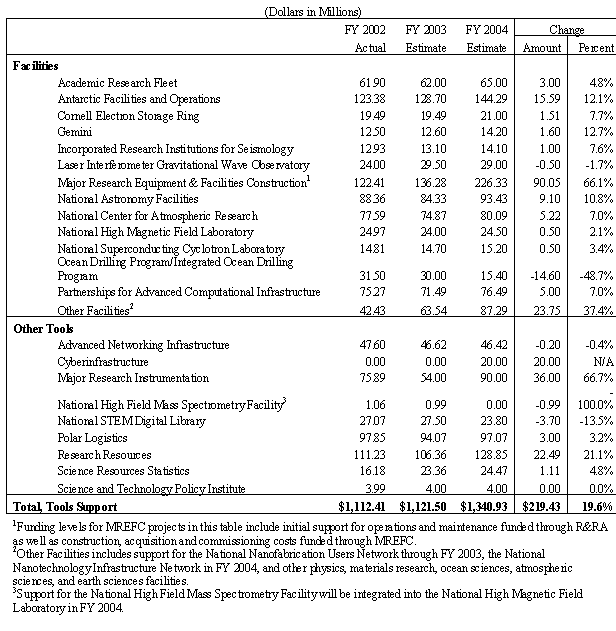Science and Engineering Infrastructure for the
21st Century
The role of the NATIONAL SCIENCE FOUNDATION
|
|
|
|
|
||||||||
 |
a BIO = Biological Sciences; CISE = Computer and Information Science
and Engineering;
ENG = Engineering; GEO = Geosciences; MPS = Mathematical and Physical
Sciences;
SBE = Social, Behavioral, and Economic Sciences; OPP = Office of
Polar Programs;
IA = Integrative Activities; EHR = Education and Human Resources.
b Other budget items include Salaries and Office of Inspector General
c Numbers may not add due to rounding.
BIO invests about 10 percent of its annual budget in the Tools category. Heretofore, the typical infrastructure investments have been in small to medium size instrumentation, such as mass spectrometers, electron microscopes, and genomic sequencers, and in stock centers, natural history collections, and searchable biological databases. The biological sciences are undergoing a profound revolution, based largely on the use of genomics data and IT advances. Hence, there are indications that BIO's future infrastructure requirements will increase substantially. (The future needs and opportunities of each directorate are discussed in the next section of the report.)
CISE supplies the critical infrastructure needs not only for computer S&E research, but also for other sciences and engineering that require high end computational and communications capabilities. Its infrastructure investment is large -28 percent of its budget - and growing rapidly. Much of the infrastructure budget provides support for two major projects: the Terascale Computing Systems (TCS) and the Partnerships for Advanced Computational Infrastructure (PACI). Additionally, CISE currently provides support for small to medium-end activities for more than 200 research universities. Resources range over the breadth of the cyberinfrastructure and include computational resources, networking testbeds, software and data repositories, and instruments.
ENG direct investment in Tools is small - only 1 percent of its budget - largely comprised of support for the NNUN. However, this direct investment is augmented by ENG's equipment investment through research grants and at NSF-supported centers, such as the Engineering Research Centers and the Earthquake Engineering Research Centers. These centers also attract a considerable investment in industry matching funds. ENG also supports the Network for Earthquake Engineering Simulation (NEES), which is funded from the MREFC Account.
EHR's current infrastructure consists of the people, computing equipment and networks, physical facilities, instrumentation, and other components that drive educational excellence and support the integration of research with education. In FY 2002, EHR will invest nearly $25 million in the National Science, Technology, Engineering, and Mathematics Education Digital Library (NSDL), a national resource that will aid researchers and educators in the development and dissemination of teaching and learning resources.
GEO spends approximately 36 percent of its total budget on infrastructure and also relies heavily on the MREFC Account. Because of its inherently observational nature, cutting-edge research in the geosciences requires a vast range of capabilities and diverse instrumentation, including ships and aircraft, ground-based observatories, laboratory and experimental analysis instruments, computing capabilities, and real-time data and communication systems.
MPS currently invests about 24 percent of its overall budget annually in the Tools category, most of which goes to the larger facilities. Like GEO, the disciplines represented by MPS require extensive observational facilities and other infrastructure. In addition, MPS facilities rely heavily on support from the NSF-wide MREFC Account.
SBE invests about 18 percent of its budget in infrastructure, comprised chiefly of distributed facilities that do not require large construction. This infrastructure includes new data collections that serve a broad range of scholars; digital libraries, including data archives; shared facilities that enable new data to be collected; and centers that promote the development of new approaches in a field.
OPP supports research across all disciplines in the two polar regions, ranging from archaeology and astrophysics to biology and space weather. OPP invests 73 percent of its budget in Tools and supports large scientific instruments; laboratories; facilities for housing, health and safety, food service, and sanitation; satellite communications; transportation (including fixed-wing aircraft, helicopters, and research ships); and data and database management, all requiring significant investment in ongoing maintenance and operations in an unforgiving climate. This infrastructure is provided for the benefit of all the research programs supported by NSF's directorates, as well as the Federal mission agencies and other institutional partners.
NSF-wide Infrastructure Programs
Major Research Equipment and Facilities Construction (MREFC) Account: NSF established the MREFC Account in 1995 to better manage the funding of large facility projects, such as accelerators, telescopes, research vessels, and aircraft, all of which require peak funding over a relatively short period of time. Previously, such projects were supported within NSF's Research and Related Activities (R&RA) Account. The MREFC Account supports facility projects that provide unique research and education capabilities at the cutting edge of S&E, with costs ranging from several tens to hundreds of millions of dollars. It provides funding for acquisition, construction, and commissioning in contrast to other activities, such as planning, design and development, and operations and maintenance, which are funded from the R&RA Account.
Table 6 indicates the projects supported by the MREFC Account since
its inception. Included are several projects approved by the NSB
but still waiting funding.
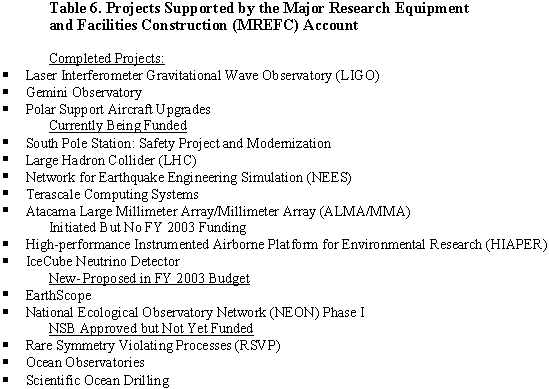 |
While the MREFC model has served NSF well, there are a number of issues that NSF is currently examining in its effort to provide the best support for large facility projects, such as:
- How large should a project be before it can be considered for
MREFC funding?
- When should large infrastructure projects be supported within
directorate budgets versus the MREFC Account?
- What costs should be charged to the MREFC Account versus the
R&RA Account?
- How should budget priorities be established across different
fields and disciplines?
- How should these large projects be managed?
Major Research Instrumentation (MRI): The MRI program supports instrumentation having a total cost ranging from $100,000 to $2 million. It seeks to improve the quality and expand the scope of research and foster the integration of research and education by providing instrumentation for research-intensive learning environments. In FY 2003 NSF has requested $54 million for this program to support the acquisition and development of research instrumentation for academic institutions. 34 This amount falls far short of meeting the real needs and opportunities, based on the survey of directorate needs and the amount of MRI proposals received in FY 2002.
Small instrumentation in research grants: In the past decade, NSF's strong support for individual investigator (and small groups of investigators) research has held steady. However, equipment within a research grant has declined from 6.9 percent to 4.4 percent of the total grant budget. This decline is partly because the average size of NSF research grants has not kept pace with inflation. Other issues include the increasing cost of new instruments, the need to replace large bulky instruments with smaller and faster instruments, and most of all, the need for computers and interfaces for the acquisition of large data sets from midrange or larger centers or sites. The potential for remote access to and operation of instruments at larger centers or sites is a key aspect of future investments at this level. In addition to increased funding for special programs, such as MRI, increasing the average size of an NSF research grant will help address the need for more attention to small-scale infrastructure.
FUTURE NEEDS AND OPPORTUNITIES
Table 7 summarizes the 10-year projection of future S&E infrastructure
requirements identified in reports provided by each of the NSF directorates
and OPP. The degree of specificity employed in identifying the requirements
ranged from listing specific facilities and instrumentation to providing
rough estimates for broad categories of infrastructure needs. Hence,
the $18.9 billion estimate of funding needed over the next 10 years
must be viewed as a rough indication of need, and not one that has
been assessed and formally endorsed by the NSB. In order to view
the commonalities and differences between scientific fields, a summary
of the infrastructure needs of each directorate and office is presented
below.
Table 7. NSF Future Infrastructure Needs, FY
2003-2012
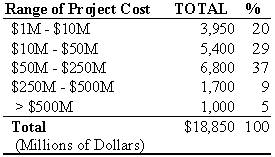 |
BIO: The use of information technology and the development of numerous new techniques have catalyzed explosive research growth and productivity. However, infrastructure investments have not kept up with the expanding needs and opportunities. For example, there is an increasing need to develop, maintain and explore huge interoperable databases that result from the determination of complete genomes. In order to thrive in the future, biological researchers will need new large concentrated laboratories where a variety of experts meet and work on a daily basis. They will also need major distributed research platforms, such as the National Ecological Observatory Network (NEON), that link together ecological sites, observational platforms, laboratories, databases, researchers and students from around the globe. An essential and neglected aspect of support for biological research is the provision of resources to make automated data analysis and interpretation procedures publicly accessible and easily usable by all investigators. Increasingly, published results are derived from intensive automated data analysis and modeling and cannot be reproduced or checked by other researchers without access to the software, which was often developed for a specific research project.
CISE: In the future, substantial investments must be made in providing increasingly powerful computational infrastructure necessary to support the increasing demands of modeling, data analysis and interpretation, management, and research. CISE researchers will require testbeds to develop and prove experimental technologies. CISE must also expand the availability of high performance computing and networking resources to the broader research and education community. Effective utilization of advanced computational resources will require more user-friendly software and better software integration. Funding for highly skilled technical support staff is essential to encouraging broader participation by the community in the evolving cyberinfrastructure.
EHR: The directorate's future needs include electronic collaboratory spaces in support of research and instruction; centers for disseminating and validating successful educational materials and practices at all levels; increased computational capacity for needs in modeling and simulation in systems research and in learning settings; and databases of international and domestic student learning indicators.
ENG: The rapid pace of technological change will require ENG to invest significantly more funds for research instrumentation and instrumentation development, multiuser equipment centers, and major networked experimental facilities, such as the National Nanotechnology Infrastructure Network, and the NEES. Needs for research tools are diverse, ranging from high-speed, high-resolution imaging technology to study gene development and expression to a suite of complex instruments that enables the simulation, design, and fabrication of novel nano- and micro-scale structures and systems. In addition, substantial investment is needed to enable engineering participation in grid activities, to facilitate collaborations between engineering and computer science researchers, and to develop tools (including improved teleoperation and visualization tools, integrated analytical tools to support real-time analysis of processes, multiscale modeling, and protocols for shared analytical codes and data sets).
GEO: In the future, the geosciences research community will require new state-of-the-art observing facilities and research platforms. Many of these facilities must be mobile and/or distributed over wide geographic locations. The increased need for distributed, interdependent observing systems will require better networking technologies, faster access to data bases and models, real-time access to data from observing platforms, and remote control of complex instruments. The increased demands for climate and environmental modeling will require high-end computational capabilities (petaflop) and new visualization tools. An essential element in future advances is the ability to integrate data from multiple observatories into models and data sets. The necessity of support, noted above for biology, for publicly accessible and usable data analysis and interpretation software applies equally here.
MPS: Mathematical and physical sciences researchers seek answers to fundamental science questions that have the potential to revolutionize how we think about nature (e.g. the origin of mass, the origin of the matter-antimatter asymmetry of the universe, the nature of the accelerating universe, and the structure of new materials). Such research increasingly requires more expensive and sophisticated instruments that range from the relatively small to the very large, such as radio observatories, neutron scattering, x-ray synchrotron radiation, high magnetic fields, neutrino detectors, and linear colliders. In addition, increased investments are needed in cyberinfrastructure to facilitate the conduct of science in the rapidly changing environment surrounding the massive petabyte data sets from astronomy and physics facilities.35 Investments include high-speed communication links, access to teraflop computing resources, and electronic communications and publishing.
OPP: With the growing realization that the polar regions offer unique opportunities for research - in fields as disparate as neutrino-based astrophysics and evolutionary biology at the genetic level - comes the need for increasingly sophisticated and diverse new instrumentation. Progress in areas such as climate change research will hinge on the development of distributed observing systems adapted to function in the harsh polar environment with minimum on-site maintenance and power requirements. Automated, intelligent underwater and airborne robotic systems will be essential in providing safe and effective access to sub-ice and atmospheric environments. High-speed connectivity to the South Pole Station must be improved to enable scientists to control instruments from stateside laboratories and to analyze incoming data in real time. Finally, the basic infrastructure that enables scientists to survive in polar regions, especially in Antarctica, must be maintained and improved.
SBE: Research in the social, behavioral and economic sciences is increasingly a capital-intensive activity. Social science research, for example, is increasingly dependent on the accumulation and processing of large data sets, requiring large computer facilities, access to state-of-the art information technologies, and employment of trained, permanent staffs. Advances in computational techniques are radically altering the research landscape in many of our communities. Examples include automated model search aids, sophisticated statistical methods, modeling, access to shared databases of enormous size, new statistical approaches to the analysis of large databases (data mining), Web-based collaboratories, virtual reality techniques for studying social behavior and interaction, and the use of computers for online experimentation.
Areas of Particular Priority
The demand for new S&E infrastructure is driven by scientific opportunity and the needs of researchers; hence, it is field dependent. However, it is not the purpose of this report to provide a detailed examination of the opportunities and needs for each scientific discipline and field. There are many discipline-specific surveys, studies and reports that do this quite well. Rather, in examining the range of need and opportunities identified in the NSF directorate reports, it is useful to consider the needs and issues they have in common. For example, the directorates identified the following areas as having particular priority:
Cyberinfrastructure: Advances in computational and communications technology are radically altering the research landscape for scientists and engineers in many disciplines. In the future, these researchers must be prepared to develop, manage and exploit an even more rapid evolution in the tools and infrastructure that empower them. Virtually all of the directorates and offices cited cyberinfrastructure as a top investment priority. The following were noted as priority needs:
- Accessing the next generation of information systems including grid computing, digital libraries and other knowledge repositories, virtual reality/telepresence, and high-performance computing and networking and middleware applications.
- Expanding the availability of high-performance computing and networking resources to the broader research and education community. As more extensive connection across the S&E community is supported, the utility of the resources to current users must also be sustained. Collaboration and coordination with State and local infrastructure efforts will also be essential. The overall goal is to provide resources and build capacity for smaller institutions while continuously enabling new research directions at the high end of computing performance.
- Providing computational infrastructure necessary to support
the increasing demands of modeling, data analysis and management,
and research. Computational resources at all levels, from desktop
systems to supercomputing, are needed to sustain progress in S&E.
The challenge is to provide scalable access to a pyramid of computing
resources from the high-performance workstations needed by most
scientists to the teraflop-and-beyond capability critically needed
for solving the grand-challenge problems.
- Increasing the ability to integrate data sets from multiple observatories into models and physically consistent data sets. Development of techniques and systems to assimilate information from diverse sources into rational, accessible, and digital formats is needed. Envisioned is a Web-accessible hierarchical network of data/information and knowledge nodes that will allow the close coupling of data acquisition and analysis to improve understanding of the uncertainties associated with observations. The system must include analysis, visualization, and modeling tools.
- Improved modeling and prediction techniques adequate for data analysis under modern conditions, which include enormous data sets with large numbers of variables, intricate feedback systems, distributed databases with related but non-identical variable sets, and hierarchically related variables. Academic groups, despite inadequate interfaces and support, now implement many of the most advanced techniques as freeware.
- Maintaining the longevity and interoperability of a growing multitude of databases and data collections.
Large Facility Projects: Over half of the needs identified by the directorates fell in the category of "large" infrastructure; i.e., projects with a total cost of $75 million or more. The reality is that many important needs identified 5 to 10 years ago have not been funded and the scientific justifications for those facilities have grown. In the past couple of years, the number of large projects approved for funding by the National Science Board, but not yet funded, has grown. The FY 2003 appropriation for the MREFC Account is about $148 million. It will require an annual investment of at least $350 million for several years to address the backlog of research facilities construction projects.
Midsize Infrastructure: Many of the NSF directorates
identified a "midsize infrastructure" funding gap. While
there is no precise definition of midsize infrastructure, for the
purposes of this report it is assumed to have a total construction/installation
cost of ranging from millions to tens of millions of dollars. Examples
of infrastructure needs that have long been identified as very high
priorities but that have not been realized include acquisition of
an incoherent scatter radar to fill critical atmospheric science
observational gaps; replacement of an Arctic regional research vessel;
replacement or upgrade of submersibles; beam line instrumentation
for neutron science; and major upgrades of computational capability.
In many cases the midsize instruments that are needed to advance
an important scientific project are research projects in their own
right, projects that advance the state-of-the-art or that invent
completely new instruments. These are not suitable for funding with
the MREFC account owing to their mix of research and instrument
construction, but they are essential if NSF is to continue to be
the agency whose work leads to developments like MRI and laser eye
surgery - developments that had their roots in research on advanced
instrumentation.
Maintaining and Upgrading Existing Infrastructure:
Obtaining the money to maintain and upgrade existing research facilities,
platforms, databases, and specimen collections is a difficult challenge
for universities. IT adds a new layer of complexity to already complex
science and engineering instruments. The design and build time for
large instruments can be two to four generations of IT; while IT
must be "planned in" - it cannot be designed in afterwards.
Instruments with long lifetimes must consider upgrade paths for
IT systems that will enable enhanced sensors, data rates or other
improved capabilities. The challenge to NSF is how to maintain and
upgrade existing infrastructure while simultaneously advancing the
state-of-the-art.
Instrumentation Research: Increased support for research
in areas that can lead to advances in instruments, in terms of cost
and function, is critically important. Such an investment will be
cost effective because skipping even one generation of a big instrument
may save hundreds of millions of dollars. Also, totally new instruments
can open doors to new research vistas. In addition, industry is
rapidly transforming the tools developed in support of basic research
into the tools and technologies of industry. At the same time, industry
is increasingly relying on NSF-sponsored fundamental research programs
in universities for the initial development of such tools.
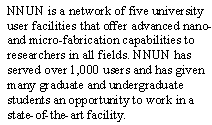 |
Polar Regions Research: NSF infrastructure in the
polar regions enables research supported not only by OPP and most
other NSF Directorates, but also by the Nation's mission agencies,
notably NASA, the Department of Interior (DoI), DoE, and the Department
of Commerce (DoC). The new South Pole Station will to enable this
research; however, improved transportation to the station will be
needed as will continuous high-bandwidth capability for data transfer
and connectivity to the cyberinfrastructure. In addition, NSF infrastructure
at McMurdo Station, the base for South Pole and remote field operations,
needs to be maintained at a faster pace than has occurred in recent
years. Finally, many fields of science require access to polar regions
during the winter months, a capability that currently can be supported
only to a very limited extent.
Education and Training: Investments that expand the educational
opportunities at research facilities have already had an enormous
impact on students. Many of these investments can 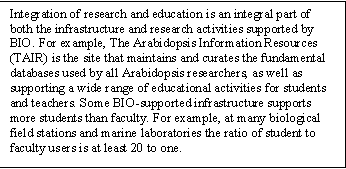 be
further leveraged by new activities that reach out to K-12 students
and influence the teaching of science and mathematics. Similarly,
the public's direct participation in advanced visualization access
to national research facilities can open a much-needed avenue for
public involvement in the excitement of scientific discovery and
the creative process of engineering.
be
further leveraged by new activities that reach out to K-12 students
and influence the teaching of science and mathematics. Similarly,
the public's direct participation in advanced visualization access
to national research facilities can open a much-needed avenue for
public involvement in the excitement of scientific discovery and
the creative process of engineering.
Infrastructure Security: The events of September 11, 2001 increased awareness of important security issues with respect to protecting the Nation's S&E infrastructure. Examples include:
- Preventing attacks on S&E infrastructure to destroy valuable
national resources and disrupt U.S. science and technology.
- Preventing use of S&E infrastructure, such as shared research
Web sites, for destructive purposes.
- Ensuring security, confidence, and trust in S&E databases.
The increasingly distributed and networked nature of S&E infrastructure
means that problems can propagate widely and rapidly. Infrastructure
security requires innovations in IT to monitor and analyze threats
in new settings of global communications and commerce, asymmetric
threats, and threats emanating from groups with unfamiliar cultures
and languages. The U.S. and its international partners face unprecedented
challenges for ensuring the security, reliability and dependability
of IT-based infrastructure systems. For example, the major barriers
to realizing the promise of the Internet are security and privacy
issues - research issues requiring further study - and the need
for ubiquitous access to broadband service. Current middleware and
strategic technology efforts are attempting to address these problems,
but a significantly greater investment is needed to do so successfully.

